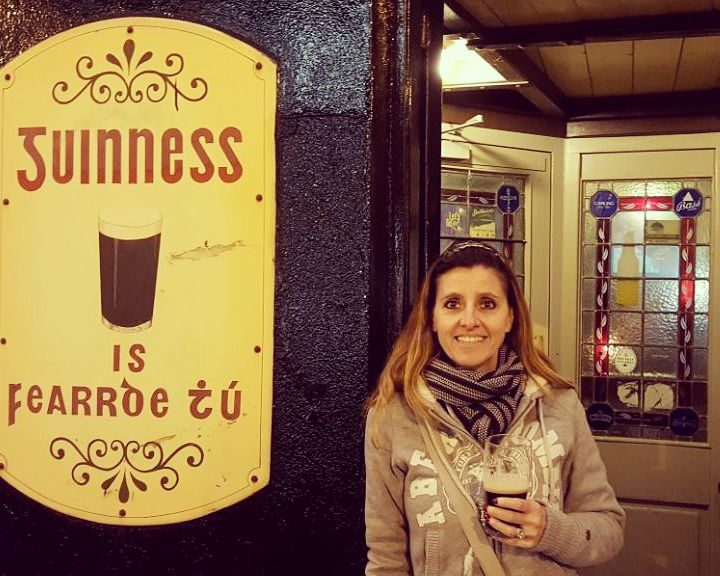KILLARNEY
20 – 21 November 2017
The main drive for the day was the Blarney to Killarney stretch, which took about an hour and 20 minutes despite being only 60 or so kilometres, thanks to single lane country roads with one or two impediments along the route.
Arriving in Killarney was surreal. A picture-perfect 19th century Stepford town that is neat as a pin but with enough allure that you want to step into its shoes.
We pulled our rental into the parking lot and were very pleased to find the hotel to be more fitting of the surroundings than the price tag. Bonus!
We dumped the bags and headed out to make the most of daylight and visit the Torc Waterfall. We unwittingly, apparently, had coincidentally managed to be in Killarney for the falls’ most impressive time of year – where there was lots of not-rain and the falls were full and gushing! We took a trot around the base of the falls, but when tempted by the path surrounding it, were put off by the slippery leaves that made the steps lethal from the not-rain.
Having sated our sense of adventure, we returned down the road to Muckross House to investigate the magnificent house and gardens (and craft shop). Nice, but nothing life-changing.
We returned to the hotel to park the car and walk into town.
Killarney was beautiful. Not a hair out of place. Pretty little streets with Christmas lights and toy soldier decals on the traffic bollards to add to the effect. Not a single facade needing so much as a touch-up of paint.
The centre see-and-do was a neat little grid lined with brightly-lit shop windows, most complete with Christmas decorations. It felt like we were walking through the set of one of those RomCom festive blockbusters!
It was still a bit early for dinner so we thought we’d sample some of the pubs by way of a sundowners pub crawl. We contrasted a very dark and dingy local spot called O’Connor’s with the more upmarket The Laurels before making our way to Murphy’s for dinner – a feast of local Kerry lamb and Kerry beef Cottage Pie.
The waitress was so friendly and free with advice that it was hard not to take her suggestion and nightcap at Reidy’s around the corner, where Christian had a taste of some *very* pricey whiskey he’d wanted to sample at Midletons, while we were entertained by the lively band and I logged our pints on our Guinness Index.
MONDAY
Killarney is well positioned to access the grand sites of Ireland’s South West. We’d already predetermined that if weather was good we’d attempt the Ring of Kerry, a 180km circular driving route that takes in some of the most breathtaking scenery in the lush inland and the dramatic coastline with its crags and cliffs. Of course, lousy weather would result in a slow and tedious drive and an album of misty pictures.
We woke up to rain and, with a full Irish breakfast on board, slipped into Plan B, the smaller Dingle Peninsula, said to be home to a wealth of historical monuments (more than 2000 archeological exhibits!), Irish culture and still have more than its fair share of beautiful scenery.
The driving was slow going compared to what we were used to, since the road was primarily (what could only be very generously described as) single lane and winding, but we were still at our first stop, Dingle, in around an hour so we carried on driving past it to see the Fahan Beehive Huts.
The huts were a collection of stone igloo-looking buildings fashioned together by piling rocks very specifically so that they overlay and overlock each other, forming a perfectly dry room beneath. They had been so carefully crafted that there were even flat rocks forming lintels and doorframes on each beehive. You could still see the fireplace alcoves so these beehives might actually have been quite snug once a toasty fire was going.
There was some conjecture as to how old these relics really were, since this form of masonry, called ‘corbelling’ had been around since into the multi-thousands BC and was still used as recently as the 1950s. The site was relatively well-preserved since the area was quite remote, but it was a pity that only 5 huts remain from the 400 more that used to fill the hill – and amazing that we were still allowed to walk around inside the huts since they were such a rare artefact.
Returning to Dingle, we took a break from the drive and had a wander around town. Another quaint and delightful little seaside town, all pubs, fish n chip restaurants, coffee shops and odds and sods shops like crafts and a haberdashery.
We concluded our visit to the Peninsular and foray with the Wild Atlantic Way with a drive to Tralee (an hour) to stop for refreshments before the final leg to Limerick, where we’d be spending the night.
